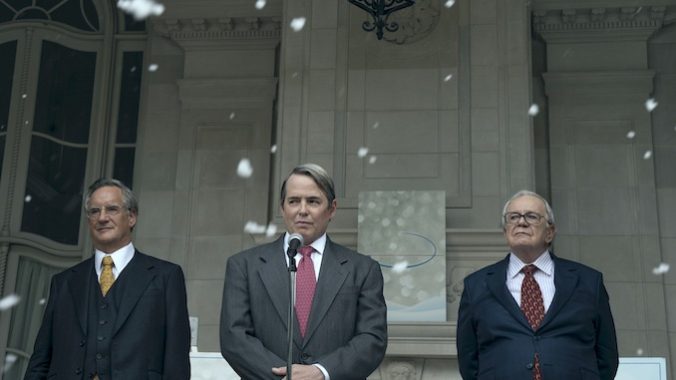Netflix’s Painkiller Effectively (and Entertainingly) Paints the Bleak Picture of the Oxycontin Plague
Photo Courtesy of Netflix
“What Purdue did, what Richard Sackler did, abusing the trust between a doctor and their patient… selling hope to the most vulnerable people, it’s sick on a whole other level. And then Richard Sackler combined two of the most addictive substances, greed and opium, and when you understand that—when you understand that—then your brain will never be able to reconcile it. And you will never see the world the same.”
To make a TV show or a movie about a social ill spurred on by naked capitalistic greed—think something as major as the subprime mortgage crisis as portrayed in The Big Short, or as minor as Adam Neumann’s communal working house of cards depicted in Apple TV+’s WeCrashed—there are, as I see it, three worthy goals to pursue:
- Successfully educate the public on what is inevitably a complex topic, using shorthand where necessary but without sacrificing accuracy.
- Do so while still making an entertaining, fictionalized viewing product, because without that, your reach is severely limited.
- Resist the urge to make the original sin—in most cases, the rise of the company that unleashed the social ill—look too sexy.
This third goal has been particularly difficult for many directors, largely because the most dynamic element of the story is the heady rise. WeCrashed ultimately failed as a show because it fell in love with Adam Neumann’s ascent and couldn’t successfully dramatize his downfall, while The Big Short worked beautifully because Adam McKay focused his story on the great undoing, and mined most of the drama in collapse. Resisting a certain amount of glorification is paramount to the “service” inherent in productions like these; if you want to make a point about society and reach enough people to have an impact, the main lesson can’t be that getting rich off other people’s pain actually looks pretty fun.
Happily, the new Netflix show Painkiller largely manages to avoid that pitfall. This is a fictionalized account of the now increasingly well-known Sackler pharmaceutical family, Purdue Pharma and its drug oxycontin, and the deadly opioid epidemic that devastated—and continues to devastate—America. Patrick Radden Keefe’s 2021 book Empire of Pain shone perhaps the brightest light on the Sackler legacy, and this six-part miniseries, directed by Peter Berg (Friday Night Lights, The Leftovers) is based on that text. And despite the necessary dramatizations, and even the occasional scene of attractive sales reps drinking champagne and dancing in clubs with that sweet opioid money, this is a faithful retelling in the broad sense.
The show’s framework is built around a series of people that are, at first, only loosely connected. Uzo Aduba is Edie, an investigator with the U.S. Attorney’s office who stumbles on oxycontin by accident, Taylor Kitsch is a mechanic who suffers a serious injury at work that requires pain management, and Matthew Broderick is Richard Sackler, the nephew of the late Arthur Sackler (Clark Gregg) whose ghost still serves as his sounding board and cheerleader at critical moments. The action flits between past and present, with the device of a legal deposition serving as de facto narrator to usher the story from Arthur Sackler’s original rise to the unleashing of oxycontin itself. And if there’s a thesis statement, it’s the quote from Edie that leads this piece: The combination of America’s two greatest addictions, money and drugs, unleashed hell on earth.
-

-

-

-

-

-

-

-

-

-

-

-

-

-

-

-

-

-

-

-

-

-

-

-

-

-

-

-

-

-

-

-

-

-

-

-

-

-

-

-








































